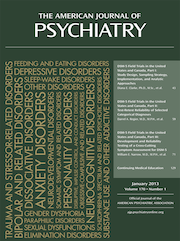Comprehensive Care of Schizophrenia: A Textbook of Clinical Management, 2nd Edition
For years, I have opened my psychiatry course by asking the students and residents for their thoughts on recovery in schizophrenia, and they always greet me with perplexed and hopeless faces. They would be surprised to know that the outcome is quite better than previously reported; Schizophrenia is no longer necessarily a constricting and life-long diagnosis. Recovery can be a reality for 42%, while 35% have an intermediate outcome, and only 27%, a bit more than one-quarter of the entire suffering people, have a poor outcome (1).
This important textbook provides most of the empirically based information needed in order to achieve the best results for each person, together with convincing data showing that, for some of them, we can pursue the goal of recovery.
The open-minded first chapter, by van Os, Murray, and First, conveniently offers a commented and updated interpretation of the literature on the diagnosis and natural history of schizophrenia and the correlation between diagnostic construct and course. There are at least eight categories in studies in the European Union and 12 in studies in the United States to be listed: combining categorical and dimensional approaches sounds like the most adequate approach to face this complexity.
Each clinician is a translation scientist committed to real-time translation of bench science to bedside clinical practice. The chapter by Girgis and Abi-Dargham on neurobiology presents the implication of this translational reasoning in terms of assessment procedure and provides the right basis for the treatment chapters, while also introducing the experimental probes.
Then there are two fascinating chapters on child and adolescent schizophrenia (by Rapoport and Frangou) and the problem of early detection of schizophrenia. The fundamental distinction between nonpsychotic premorbid and prodromal symptomatology is clearly stated.
The concept of the clinical staging model with different foci—ultra-high risk, first episode, and the recovery or critical period of the first 5 years after the diagnosis (2)—is of crucial importance in this new framework of schizophrenia, considering that about 75% of those who develop a first episode of psychosis will progress to a schizophrenia diagnosis (3).
I think the clinical staging model that considers the degree of extent, progression, and biological impact may represent the “state-of-the-art” approach to the complexity of the phenotype. The potential benefit of staging would be the better coordination and definition of the treatment, either pharmacological or behavioral, including family interventions.
Since we have multifunctional drugs, the two chapters on treatment—two textbooks themselves with about 300 references included—teach all you need to know about the everyday use of these drugs and new compounds, presented with the necessary support to decide the specific target dimension for each of them.
The next four chapters address the real-world issues of cognitive-behavioral therapy for schizophrenia patients, rehabilitative intervention, community treatment, and nonadherence to treatment, while at the same time covering the importance of dissemination to population-based community interventions.
This book approaches two other central issues: the clinical management of both suicidal behavior and aggressiveness/violence, followed by the analysis of substance abuse behavior. This vulnerable population is prone to polydrug abuse at the rate of 40%–60%, making the issue of substances one of the major problems of today.
The chapter on comorbidity is also a very helpful section, now that we are aware of the importance of the prompt recognition and assessment of it, as it has been a too often neglected side of the clinical psychopathology of major psychosis. Medical comorbidity is an arising issue because as psychiatrists, we need to care about the whole person, and our work must be directed toward an increase in the quality of life as well as of the life expectancy itself in this population already prone to illness.
The issue of gender difference is a very recent acquisition of psychiatry, and this textbook brilliantly highlights its major aspects. As for the genetics contribution, we know that we are not far away from including genetic information in the assessment process.
Economic matters in the age of the Patient Protection and Affordable Care Act are closely connected with the empowerment and perception of the suffering, and I found it very appropriate that the chapter on economic matters was placed close to the first-person account section. We have learned that a better outcome is not directly correlated to a higher rate of spending, rather the personalized treatment would assess all the faces of the phenomena, with interventions that have to be timely and coordinated, not necessarily the most expensive.
In addition, we still need a fundamental shift in our thinking from pessimism to a reasonable optimism (chapter 4, by McGorry and Addington). One central message is that we should dedicate more time to disseminating this new knowledge to population-based community interventions. We must listen to but also study the people who have recovered from schizophrenia, as well as their caregivers: they have a lot to teach us, and this volume states it.
Next year, I will open my course by asking my students and residents to give this excellent book a close read, but it is also valuable reading for professionals, researchers, and laymen: the sum of the chapters make up a new culture for the care of schizophrenia patients.
1 : A systematic review of longitudinal outcome studies of first-episode psychosis. Psychol Med 2006; 36:1349–1362Crossref, Medline, Google Scholar
2 : Clinical staging of psychiatric disorders: a heuristic framework for choosing earlier, safer and more effective interventions. Aust N Z J Psychiatry 2006; 40:616–622Crossref, Medline, Google Scholar
3 : Psychosis prediction: 12-month follow up of a high-risk (prodromal) group. Schizophr Res 2003; 60:21–32Crossref, Medline, Google Scholar



